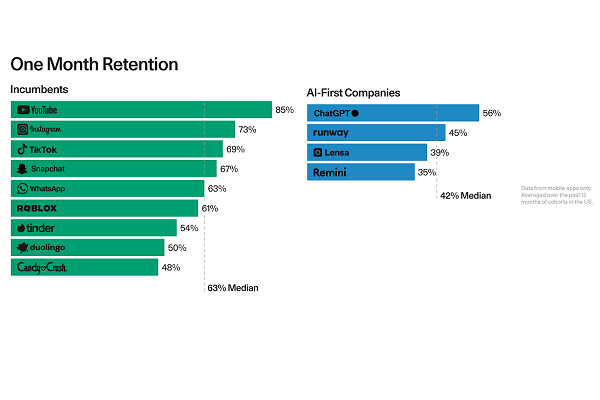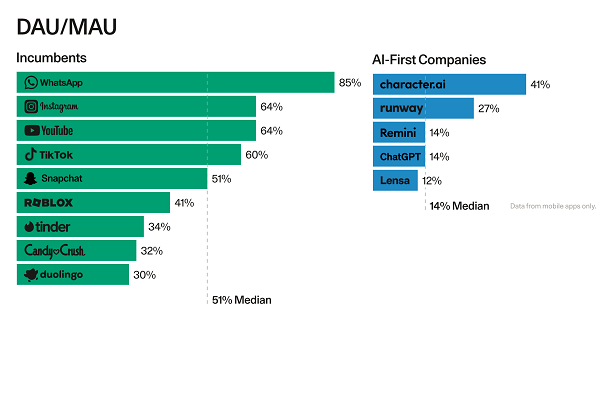Generative AI Apps Struggle With Retention and Engagement [Charts]
 Generative AI mobile apps are quick to attract a user base, but they don’t always stick around or regularly use them, according to a new report from Sequoia Capital. The “Generative AI’s Act Two” report found that the more familiar ‘incumbent’ apps are far more likely to still be on a smartphone and getting opened daily than those centered around generative AI, including ChatGPT, video creator Runway, or synthetic image generators and editors Lensa and Remini.
Generative AI mobile apps are quick to attract a user base, but they don’t always stick around or regularly use them, according to a new report from Sequoia Capital. The “Generative AI’s Act Two” report found that the more familiar ‘incumbent’ apps are far more likely to still be on a smartphone and getting opened daily than those centered around generative AI, including ChatGPT, video creator Runway, or synthetic image generators and editors Lensa and Remini.
All of the generative AI services experience significantly higher drop-offs after initial signup. The median one-month retention for generative AI apps is just 42% compared to 63% for consumer entertainment, social media, games, and education apps. YouTube had the highest retention at 85% while the most enduring generative AI app, ChatGPT, remained on just 56% of phones it had been downloaded to a month earlier, not much higher than CandyCrush at 48%, the lowest of the consumer apps. 
The ratio of daily active users to monthly active users paints an even bleaker picture for generative AI apps, even with the addition of Character AI’s mobile app. The analysis found a median DAU/MAU ratio of only 14% across generative AI services compared to 51% for the incumbents. While YouTube falls to third place at 64% and WhatsApp hits 85% as a DAU/MAU ratio, Character AI tops the AI-first companies at 41%, and ChatGPT boasts just 14%.
The findings indicate most people who try out generative AI apps fail to make them a habit and source of everyday value. The apps suffer from poor repeat use despite much excitement and rapid adoption. The researchers suggest generative AI’s biggest obstacle right now is less about use cases or initial buzz and more about retention. Turning early fascination into continuous engagement remains elusive.
“Generative AI is not lacking in use cases or customer demand. Users crave AI that makes their jobs easier and their work products better, which is why they have flocked to applications in record-setting droves (in spite of a lack of natural distribution). But do people stick around? Not really,” the report states. “This means that users are not finding enough value in Generative AI products to use them every day yet. In short, generative AI’s biggest problem is not finding use cases or demand or distribution, it is proving value.”
Follow @voicebotai Follow @erichschwartz








